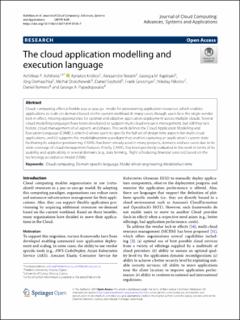| dc.contributor.author | Achilleos, Achilleas | |
| dc.contributor.author | Kritikos, Kyriakos | |
| dc.contributor.author | Rossini, Alessandro | |
| dc.contributor.author | Kapitsaki, Georgia | |
| dc.contributor.author | Domaschka, Jörg | |
| dc.contributor.author | Orzechowski, Michal | |
| dc.contributor.author | Seybold, Daniel | |
| dc.contributor.author | Griesinger, Frank | |
| dc.contributor.author | Nikolov, Nikolay | |
| dc.contributor.author | Romero, Daniel | |
| dc.contributor.author | Papadopoulos, George A. | |
| dc.date.accessioned | 2022-01-10T13:11:47Z | |
| dc.date.available | 2022-01-10T13:11:47Z | |
| dc.date.created | 2020-01-20T11:16:01Z | |
| dc.date.issued | 2019 | |
| dc.identifier.citation | Journal of Cloud Computing - Advances, Systems and Applications. 2019, 8 (20), 1-25. | en_US |
| dc.identifier.issn | 2192-113X | |
| dc.identifier.uri | https://hdl.handle.net/11250/2836757 | |
| dc.description.abstract | Cloud computing offers a flexible pay-as-you-go model for provisioning application resources, which enables applications to scale on-demand based on the current workload. In many cases, though, users face the single vendor lock-in effect, missing opportunities for optimal and adaptive application deployment across multiple clouds. Several cloud modelling languages have been developed to support multi-cloud resource management, but still they lack holistic cloud management of all aspects and phases. This work defines the Cloud Application Modelling and Execution Language (CAMEL), which (i) allows users to specify the full set of design time aspects for multi-cloud applications, and (ii) supports the models@runtime paradigm that enables capturing an application’s current state facilitating its adaptive provisioning. CAMEL has been already used in many projects, domains and use cases due to its wide coverage of cloud management features. Finally, CAMEL has been positively evaluated in this work in terms of its usability and applicability in several domains (e.g., data farming, flight scheduling, financial services) based on the technology acceptance model (TAM). | en_US |
| dc.language.iso | eng | en_US |
| dc.publisher | Springer | en_US |
| dc.relation.uri | https://link.springer.com/article/10.1186/s13677-019-0138-7 | |
| dc.rights | Navngivelse 4.0 Internasjonal | * |
| dc.rights.uri | http://creativecommons.org/licenses/by/4.0/deed.no | * |
| dc.subject | Cloud computing | en_US |
| dc.subject | Domain-specific language | en_US |
| dc.subject | Model-driven engineering | en_US |
| dc.subject | Models@run-time | en_US |
| dc.title | The cloud application modelling and execution language | en_US |
| dc.type | Peer reviewed | en_US |
| dc.type | Journal article | en_US |
| dc.description.version | publishedVersion | en_US |
| dc.rights.holder | © The Author(s). 2019 Open Access This article is distributed under the terms of the Creative Commons Attribution 4.0 International License (http://creativecommons.org/licenses/by/4.0/), which permits unrestricted use, distribution, and reproduction in any medium, provided you give appropriate credit to the original author(s) and the source, provide a link to the Creative Commons license, and indicate if changes were made. | en_US |
| dc.source.pagenumber | 1-25 | en_US |
| dc.source.volume | 8 | en_US |
| dc.source.journal | Journal of Cloud Computing - Advances, Systems and Applications | en_US |
| dc.source.issue | 20 | en_US |
| dc.identifier.doi | 10.1186/s13677-019-0138-7 | |
| dc.identifier.cristin | 1777431 | |
| dc.relation.project | EC/FP7/317715 | en_US |
| cristin.unitcode | 7401,90,12,0 | |
| cristin.unitname | Software and Service Innovation | |
| cristin.ispublished | true | |
| cristin.fulltext | original | |
| cristin.qualitycode | 1 | |

